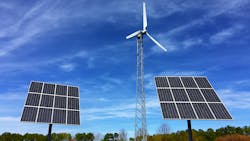Beyond Transmission: Leveraging DER for a Carbon-Free Grid
Thanks to recent federal and state legislation, the White House’s clean electricity and decarbonization-by-electrification targets are now within reach. But delivering on that promise is easier said than done.
Electric transmission capacity constraints—which are costly for electric power providers and suppress the interconnection of new renewable energy resources—threaten to scuttle the emissions reductions promised by recent legislation.
One clear solution is transmission permitting reform. But neither utilities nor the communities they serve can risk putting all their grid decarbonization eggs in the transmission permitting reform basket. While transmission capacity additions are unequivocally necessary, a singular focus on this supply-side solution ignores the opportunity to advance decarbonization and bolster reliability, resilience, and affordability on the demand side as well.
By leveraging the load flexibility made possible by fleets of interconnected, customer-sited distributed energy resources (DER), utilities can reduce congestion on existing lines, and help to get more from the transmission infrastructure that’s already in place. This will buy them some time to keep pace with increasing demand as the pressures of electrification hit the grid, and to make more effective use of the renewable energy that’s already installed.
But they’ll need to act quickly. The rate of customer load growth is outpacing utilities’ traditional integrated resource planning, sticking power providers’ operations teams with much of the burden of adapting to harder-to-predict load growth. And this phenomenon will only intensify. Consumer tax credits and rebates made available by the IRA, among other federal and state funding mechanisms and regulations, promise to accelerate the adoption of electric vehicles, rooftop solar panels, home batteries, heat pumps, and other potential disruptors to “business as usual.”
Wariness among utilities about engaging with behind-the-meter resources is understandable; managing the complexity of orchestrating local, distribution-level energy resources, not to mention the delicacy of customer and member relations, are significant responsibilities to take on. Moreover, many large, investor-owned power providers lack the incentive to make better use of infrastructure they don’t own. However, electric utilities can neither afford to ignore the hazards presented by uncoordinated local energy resources nor can they leave by the wayside the opportunities to leverage them.
One key opportunity is the establishment and coordination of what might be called “grid-aware” virtual power plants (VPPs), a process enabled by advanced visibility and control into customer-sited DER, as well as the buy-in of utility customers.
VPPs offer utilities a means to aggregate and coordinate the flexibility of customer-sited DERs, enabling them to provide energy, capacity, and ancillary services. These grid-aware VPPs can either be stood up and operated directly by the utility, or by third-party aggregators who receive dynamic operating envelopes from the utility. What separates a “grid-aware” VPP from today’s VPPs is the awareness of and ability to respond to a range of distribution- and transmission-level constraints in coordination with the utility.
At the local level, grid-aware VPPs enable utilities to better manage distribution network congestion, lessening the strain on their infrastructure and mitigating the risk of service disruptions. At scale, these aggregated DERs bring advantages to all customers within the orchestrating utility’s service area, lowering operating costs and boosting network reliability. Importantly, as new distribution-connected resources are incorporated into an orchestrated network of VPPs, the utility gains greater insight into its own capacity needs and is better able to leverage local flexibility to alleviate transmission capacity constraints when they inevitably arise.
In taking this approach, utilities will be assuming the role of a distribution system operator (DSO), an emerging model for grid performance management whereby utilities can affordably and safely drive emissions reductions by influencing the behavior of connected DER in near real-time.
This digitally-enabled pathway toward more agile, forward-looking grid management ought to appeal to distribution utilities, transmission system operators, and the consumers they serve together. For one, VPPs and other methods of DER orchestration lessen the need for transmission and distribution capacity additions, among other capital-intensive “hard” infrastructure grid adaptations. Second, beyond shoring up grid resilience and reliability, the application of DER orchestration solutions enables utilities to strengthen their relationships with their customers by compensating VPP-participating customers for the services that their orchestrated devices provide to the grid.
At its core, the impetus for transmission permitting reform is to remove the principal barrier preventing utilities and other power providers from delivering carbon-free, renewable energy to end users when and where they need it. The inconvenient truth is that we can’t rely on transmission build-outs to achieve our decarbonization goals. Fortunately, demand-side resources, when well-orchestrated, offer an additional tool that can help us achieve our decarbonization goals. With the stakes so high, we need to use all tools available to us—including and especially local energy resources.
Astrid Atkinson is the co-founder and CEO of Camus Energy, whose cloud-native software enables the community-led transition to a zero-carbon grid by empowering electric utilities with system-wide visibility into and advanced controls for utility-owned and customer-sited energy devices.
About the Author
Astrid Atkinson
Astrid Atkinson is the co-founder and CEO of Camus Energy, whose cloud-native software enables the community-led transition to a zero-carbon grid by empowering electric utilities with system-wide visibility into and advanced controls for utility-owned and customer-sited energy devices.
